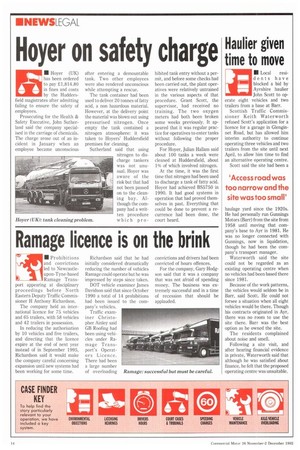Hoyer on safety charge
Page 16

If you've noticed an error in this article please click here to report it so we can fix it.
• Hoyer (UK) has been ordered to pay £1,814.80 in fines and costs by the Huddersfield magistrates after admitting failing to ensure the safety of employees.
Prosecuting for the Health & Safety Executive, John Sutherland said the company specialised in the carriage of chemicals. The charge arose out of an incident in January when an employee became unconscious after entering a demountable tank. Two other employees were also rendered unconscious while attempting a rescue.
The tank container had been used to deliver 20 tonnes of fatty acid, a non hazardous material. However, at the delivery point the material was blown out using pressurised nitrogen. Once empty the tank contained a nitrogen atmosphere: it was taken to Hoyers' Huddersfield premises for cleaning.
Sutherland said that using nitrogen to discharge tankers was not unusual. Hoyer was aware of the risk but that had not been passed on to the cleaning bay. Although the company had a written procedure which pro hibited tank entry without a permit, and before some checks had been carried out, the plant operatives were relatively untrained in the various aspects of that procedure. Grant Scott, the supervisor, had received no training. The two oxygen meters had both been broken some weeks previously. It appeared that it was regular practice for operatives to enter tanks without following the proper procedure.
For Hoyer, Julian Hallam said about 100 tanks a week were cleaned at Huddersfield, about 1% of which involved nitrogen.
At the time, it was the first time that nitrogen had been used to discharge a tank of fatty acid. Hoyer had achieved BS5750 in 1990. It had good systems in operation that had proved themselves in past. Everything that could be done to prevent a recurrence had been done, the court heard.












































































